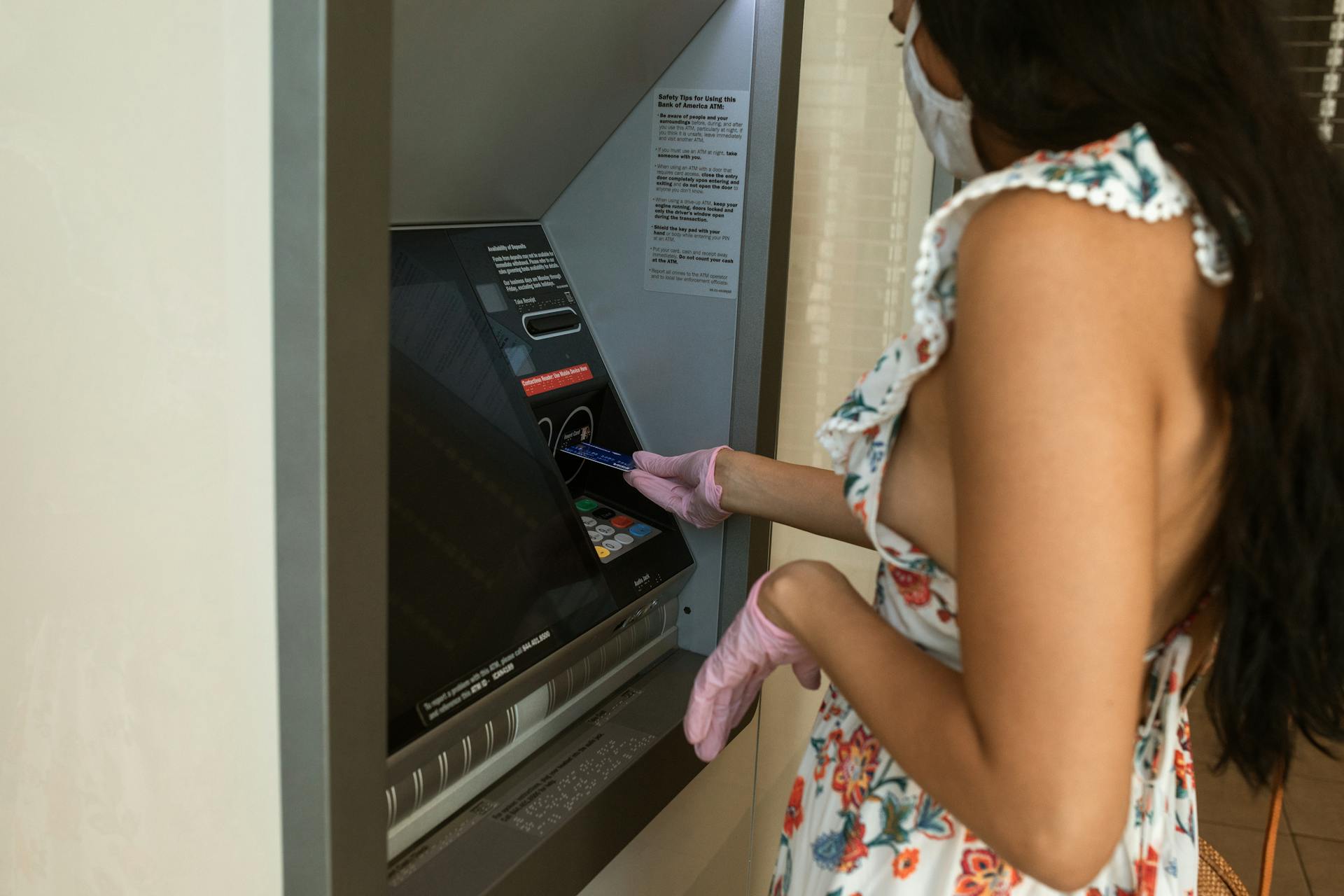
Cash against documents is a payment method where a buyer pays a seller after presenting specific documents, such as invoices or bills of lading. This method is commonly used in international trade.
It's a secure way for buyers to verify the authenticity of documents before making a payment. This reduces the risk of fraud and ensures that the documents are legitimate.
In a cash against documents transaction, the payment is typically made within a specified timeframe, usually 30 to 60 days after the documents are presented. This allows the buyer to review the documents carefully before making a payment.
The seller, on the other hand, benefits from this method as it provides a level of assurance that the payment will be made once the documents are presented.
You might enjoy: Kyc Document
What is Cash Against Documents
Cash Against Documents is a payment agreement that involves the bank acting as a neutral entity to hold shipping documents until the importer pays in full.
This method differs from other payment terms that essentially act as a time frame during which the seller can expect payment. It's a powerful mechanism that secures payments and the exchange of goods, instilling confidence in both the buyer and seller.
In essence, Cash Against Documents is a level up from standard invoice payment terms.
Process and Components
The Cash Against Documents process is a complex system that involves several key components. The exporter or seller typically initiates the CAD transaction by preparing the necessary shipping documents required by the country of origin and country of destination.
These documents include a standard form called an Export Collection Form, a bill of exchange, and other shipping documents. The exporter forwards these documents to the financial institution used by the exporter.
A crucial component of the CAD process is the financial institution, which holds the documents until the designated payment is made. The transaction is not complete, and the seller retains ownership of the entire shipment until the financial institution receives the payment.
The buyer benefits from this process as they can inspect the goods before transferring the funds to the financial institution, ensuring the products are of the quality promised and in the quantity requested.
Here are the key components involved in a CAD transaction:
- Export Collection Form
- Bill of exchange
- Shipping documents
- Financial institution
- Exporting party
- Importing party
The exporter retains ownership of the goods until the transfer of funds, and the importer cannot take ownership of the property until they have the title and shipping documents.
Benefits and Risks
Using cash against documents (CAD) can be a game-changer for international trade, offering several benefits for both exporters and importers.
One of the main advantages of CAD is that it provides payment assurance for the exporter. The buyer must make the payment before taking possession of the documents, ensuring that the exporter receives the payment in a timely manner.
This reduces the risk of non-payment or disputes over payment terms, making it a more secure option for exporters. CAD also eliminates the possibility of non-payment by providing a hedge, as the buyer will not be able to possess the goods without completing payment formalities.
However, there are also some potential drawbacks to consider. The buyer could receive goods before the payment process and might delay the payments, which can create additional complexities in the international trade process.
Another potential risk is that if the buyer refuses to pay, the goods get stuck in the middle, and the seller might have to bear the cost of shipping them back. This can be a significant financial burden for the exporter.
Here are some of the key benefits and risks of using CAD:
Overall, CAD can be a useful tool for exporters and importers looking to simplify the payment process and reduce the risk of non-payment. However, it's essential to carefully consider the potential risks and drawbacks before making a decision.
Types of Financing
Cash Against Documents financing is a specific type of trade finance that involves exchanging documents to facilitate international and domestic trade transactions. This method ensures the seller gets paid and the buyer has assurance that the goods have been shipped.
Check this out: What Is Trade Credit Insurance
In trade finance, CAD financing is preferred for its simplicity and lower cost compared to some of the more complex instruments like letters of credit. Trade finance itself includes various other instruments and methods, such as letters of credit, bank guarantees, export financing, import financing, and supply chain financing.
Here are some benefits of CAD Financing with Bankers:
- Sellers/Exporters can guarantee payment
- Buyers/Importers can inspect goods before making payment
- Bankers Factoring, a third-party control the shipment and payment process
- The buyer does not need to obtain a letter of credit
- Goods can be FOB, Foreign Country of Origin or FOB USA
- A financing solution when you lack working capital
Is Financing a Term for Trade Finance?
Cash Against Documents (CAD) financing is a specific type of trade finance that's used to facilitate international and domestic trade transactions. It's a method where payment for goods is made through the exchange of certain documents.
Trade finance encompasses a wide range of financial products, including letters of credit, bank guarantees, export financing, import financing, and supply chain financing. Each of these serves different needs and scenarios in the facilitation of trade.
CAD financing is preferred for its simplicity and lower cost compared to some of the more complex instruments like letters of credit. This makes it a popular choice for businesses looking for a straightforward financing solution.
Suggestion: Finance for Trading
Here are some benefits of CAD Financing with Bankers:
- Sellers/Exporters can guarantee payment
- Buyers/Importers can inspect goods before making payment
- Bankers Factoring, a third-party controls the shipment and payment process
- The buyer does not need to obtain a letter of credit
- Goods can be FOB, Foreign Country of Origin or FOB USA
- A financing solution when you lack working capital
Letter of Credit (L/C)
A Letter of Credit (L/C) is a widely used payment method that provides payment security for both the buyer and seller. It guarantees payment to the seller upon the presentation of specified documents that comply with the terms and conditions of the L/C.
The buyer's bank acts as a trust anchor, offering a structure that ensures both parties stick to the payment terms and all documents are accurate. This process involves the buyer's bank promising financial support to the buyer, which gives the exporter the right to demand payment from the bank if the buyer doesn't pay.
A Letter of Credit can be a one-time purchase, or the buyer could establish a line of credit with the financial provider that allows them to make regular purchases from the same exporter. This method affects the buyer's line of credit and credit score, potentially interfering with their ability to deal with other vendors or take out business loans.
If this caught your attention, see: Commercial Letter of Credit
The seller gets the most advantage from letters of credit, as their payment is virtually guaranteed unless there is a severe breach of the agreement they have made with the importer. However, the buyer may need to put up cash or be very bankable to qualify for a letter of credit, and the service fee can be high.
Here are some key characteristics of a Letter of Credit:
- Guarantees payment to the seller upon presentation of specified documents
- Requires the buyer's bank to promise financial support to the buyer
- Can be a one-time purchase or a line of credit
- Affects the buyer's line of credit and credit score
- Has a high service fee
Transaction and Funding
Many banks charge higher fees for CAD services, but private companies have the experience and knowledge to handle these complex transactions.
Funding companies deal with CAD transactions daily, making them better equipped to handle the paperwork involved. They have gained experience in international import and export, which ensures successful CAD transactions.
Bankers Factoring acts as the import financing intermediary, supplying funds through purchase order financing and invoice factoring.
The buyer must make payment before taking possession of the documents, ensuring the exporter receives payment in a timely manner. This provides financial security and helps maintain a positive cash flow for the exporter.
CAD is used when the buyer is unable or unwilling to make advance payment, providing a solution that allows the buyer to make the payment upon receipt of the necessary documents.
The use of CAD allows textile exporters to receive payment upon the presentation of the necessary documents, providing financial security and reducing the risk of non-payment.
Documents Against Payment (D/P) is similar to CAD, where the buyer makes payment upon receipt of the documents, but it does not necessarily require the involvement of a bank as in the case of L/C.
Payment and Clearance
Using CAD for customs clearance provides payment assurance for the exporter, ensuring they receive payment in a timely manner.
The buyer must make the payment before taking possession of the documents, which helps maintain a positive cash flow for the exporter.
CAD is also a solution when the buyer is unable or unwilling to make advance payment for the goods, due to financial constraints, payment terms, or the nature of the transaction.
This payment method allows the buyer to make the payment upon receipt of the necessary documents, providing a flexible option for both parties.
Documents against Payment (D/P) is another payment method where the buyer makes payment upon receipt of the documents, providing assurance to the seller.
However, D/P does not necessarily require the involvement of a bank, unlike Cash Against Documents (CAD).
To ensure a smooth process when using CAD for customs clearance, there are some key tips to keep in mind.
Alternatives and Regulations
There are alternative payment methods to Cash Against Documents (CAD) for customs clearance. CAD is just one of many options available.
Using CAD in the textile industry offers several benefits for exporters, including payment assurance, reduced risk of non-payment, and faster customs clearance.
However, textile exporters also face challenges when using CAD, such as the risk for the importer and higher cost for the importer.
Frequently Asked Questions
What is the difference between cash against document and letter of credit?
A Letter of Credit is a trust-building mechanism for new business relationships, while Cash Against Document (CAD) is a payment process between buyer and seller. The key difference lies in their purpose and usage, with a Letter of Credit serving as a foundation for credit terms and CAD being a direct payment method.
Sources
- https://ecapital.com/blog/what-is-cash-against-documents-cad-financing/
- https://altline.sobanco.com/what-is-cash-against-documents-and-how-does-it-work/
- https://www.bankersfactoring.com/what-is-cash-against-document-cad-financing/
- https://ecustomsclearing.com/what-is-a-cash-against-documents-cad-and-when-is-it-used-for-customs-clearance/
- https://www.wallstreetmojo.com/documents-against-payment/
Featured Images: pexels.com


